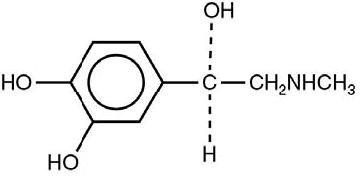Adyphren Amp
Generic name: epinephrine and isopropyl alcohol
Dosage form: kit
Disclaimer: This drug has not been found by FDA to be safe and effective, and this labeling has not been approved by FDA. For further information about unapproved drugs, click here.
On This Page
EPINEPHRINE
Injection, USP
1 mg/mL
Ampul
Protect from light until ready to use.
Rx only
DESCRIPTION
Epinephrine Injection, USP 1 mg/mL is a sterile, nonpyrogenic solution. Each mL contains epinephrine 1 mg; sodium chloride 9 mg; sodium metabisulfite 0.9 mg added. May contain hydrochloric acid for pH adjustment.
The solution contains no bacteriostat or antimicrobial agent. It is administered by the following routes: intravenous, intracardiac (left ventricular chamber), via endotracheal tube into the bronchial tree, subcutaneous or intramuscular.
Epinephrine, USP is a sympathomimetic (adrenergic) agent designated chemically as 4-[1-hydroxy-2 (methylamino) ethyl]-1,2 benzenediol, a white, microcrystalline powder. It has the following structural formula:
Sodium Chloride, USP is chemically designated NaCl, a white, crystalline compound freely soluble in water.
CLINICAL PHARMACOLOGY
The actions of epinephrine resemble the effects of stimulation of adrenergic nerves. To a variable degree it acts on both alpha and beta receptor sites of sympathetic effector cells. Its most prominent actions are on the beta receptors of the heart, vascular and other smooth muscle. When given by rapid intravenous injection, it produces a rapid rise in blood pressure, mainly systolic, by (1) direct stimulation of cardiac muscle which increases the strength of ventricular contraction, (2) increasing the heart rate and (3) constriction of the arterioles in the skin, mucosa and splanchnic areas of the circulation.
When given by slow intravenous injection epinephrine usually produces only a moderate rise in systolic and a fall in diastolic pressure. Although some increase in pulse pressure occurs, there is usually no great elevation in mean blood pressure. Accordingly, the compensatory reflex mechanisms that come into play with a pronounced increase in blood pressure do not antagonize the direct cardiac actions of epinephrine as much as with




